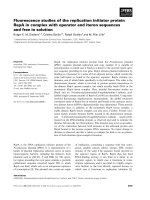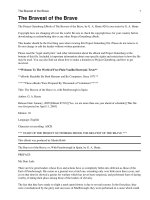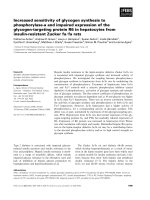Functions of the dynamin like protein VPS1 in actin organization in saccharomyces cerevisiae
Bạn đang xem bản rút gọn của tài liệu. Xem và tải ngay bản đầy đủ của tài liệu tại đây (11.38 MB, 225 trang )
FUNCTIONS OF THE DYNAMIN-LIKE PROTEIN
VPS1 IN ACTIN ORGANIZATION IN
SACCHAROMYCES CEREVISIAE
YU XIANWEN
INSTITUTE OF MOLECULAR AND CELL BIOLOGY
NATIONAL UNIVERSITY OF SINGAPORE
2005
FUNCTIONS OF THE DYNAMIN-LIKE PROTEIN
VPS1 IN ACTIN ORGANIZATION IN
SACCHAROMYCES CEREVISIAE
YU XIANWEN
(B.Sc., XIAMEN UNIVERSITY)
A THESIS SUBMITTED
FOR THE DEGREE OF DOCTOR OF PHILOSOPHY
INSTITUTE OF MOLECULAR AND CELL BIOLOGY
NATIONAL UNIVERSITY OF SINGAPORE
2005
ACKNOWLEDGEMENTS
Foremost, I would like to express my gratitude to my supervisor A/P Mingjie Cai, for
providing me the opportunity to pursue my Ph.D. research work in his laboratory. I am
deeply grateful to A/P Cai for his supervision, guidance, tolerance, and support
throughout my graduate studies, and for his invaluable amendments to this thesis. My
sincere thanks also go to the members of my graduate supervisory committee, A/P
Thomas Leung and A/P Walter Hunziker for their constructive comments and
encouragement during the course of this work. My special thanks also go to Dr. Alan
Munn (Institute for Molecular Bioscience, the University of Queensland) for his
invaluable scientific advice and assistance in the endocytosis assay.
I would like to thank the past and present members in CMJ laboratory, for their
helpful discussion, technique assistance, cooperation, and friendship. Special thanks go
to Dr. Hsin-yao Tan, Dr. Guoliang Tian, and Dr. Guisheng Zeng, for their help, advice,
and sharing of experience. Thanks also go to Miss Suat Peng Neo and Mr. Jeff Wui
Kheng Seow, for their critical reading of my thesis.
Many thanks also go to the past and present members in US laboratory, to Dr. Hong
Hwa Lim, Dr. Foong May Yeong, Dr. Vaidehi Krishnan, Miss Karen Crasta, Mr. Tao
Zhang, and Mr. Saurabh Nirantar, for their interesting discussions and help with the
project. Especially, I am deeply grateful to Dr. Padmashree C.G. Rida, for her critical
reading of my manuscript and this thesis, and also for her constant and kind help
whenever I needed. I would like to express my gratitude to Dr. Lei Lu in HWJ laboratory
for his helpful discussions and suggestions pertaining to the project. I also appreciate the
excellent services from the various administrative and technical staffs in IMCB which are
indispensable to fulfill my studies.
Finally, my heartfelt and deepest appreciation goes to my husband, Canhe Chen, for
his love, patience, understanding, and support over these years. Last but not the least, this
thesis is dedicated to my beloved parents, for their unwavering support and belief in me
throughout the journey of my studies.
Xianwen Yu
January, 2005
Table of Contents ii
TABLE OF CONTENTS
CHAPTER I Introduction
1
1.1 General introduction
2
1.1.1 Endocytosis 2
1.1.2 Endocytic signals 3
1.2 Formation of endocytic vesicle
6
1.2.1 Vesicle formation in clathrin-mediated endocytosis 6
1.2.1.1 Clathrin and clathrin adaptor protein AP-2 6
1.2.1.2 Clathrin accessory factors 8
1.2.2 Vesicle formation in caveolae-dependent pathway 9
1.2.3 Vesicle formation in macropinocytosis and phagocytosis 10
1.3 Roles of dynamin in endocytic vesicle formation
11
1.3.1 Dynamin and dynamin-related proteins 12
1.3.1.1 Domains and properties of dynamins 14
ACKNOWLEDGEMENTS
TABLE OF CONTENTS
ii
LIST OF FIGURES
ix
LIST OF TABLES
xii
ABBREVIATIONS
xiii
SUMMARY
ii
Table of Contents iii
1.3.1.2 Properties of dynamin-related proteins 18
1.3.2 Roles of dynamin in the release of clathrin-coated vesicles
(CCVs)
18
1.3.2.1 Dynamins interact with a subset of accessory factors
in the formation of CCVs
18
1.3.2.2 Functions of dynamin and its interacting partners
in the distinct stages of CCV formation
23
1.3.2.3 Dynamin may function as a force-generating GTPase 26
1.3.2.4 Dynamin may function as a regulatory enzyme 29
1.3.3 Roles of dynamins in clathrin-independent endocytosis 31
1.4 Roles of actin in endocytosis
33
1.4.1 Overview of the connections between actin and endocytosis 33
1.4.2 Actin and dynamic actin polymerization 34
1.4.2.1 Actin treadmilling and its regulators 34
1.4.2.2 Structure of yeast actin cytoskeleton 38
1.4.2.3 Regulation of actin cytoskeleton in yeast 42
1.4.2.3.1 The regulation of cortical patch assembly 42
1.4.2.3.2 Assembly and polarization of actin cables 47
1.4.2.4 Functions of yeast actin cytoskeleton 49
1.4.2.4.1 Actin cables in organelle segregation, mRNA
inheritance, and polarized secretion
49
1.4.2.4.2 Cortical actin patch in endocytosis and 50
cell wall morphogenesis
1.4.3 Involvement of actin assembly in yeast endocytosis 53
1.4.3.1 Yeast as a model system for the study of endocytosis 53
Table of Contents iv
1.4.3.2 Intact actin cytoskeleton organization is required for
endocytosis
55
1.4.3.3 Possible roles of actin cytoskeleton in the endocytic
pathway
58
1.4.4 Actin organization in endocytosis of higher eukaryotes 59
1.4.4.1 Roles of actin in endocytosis of higher eukaryotes:
important but not obligatory
59
1.4.4.2 Links between endocytic machinery and
actin cytoskeleton
62
1.5 Endocytosis in mammals and yeast: a comparison
65
1.5.1 Similarities in the endocytic pathway of mammals and yeast 65
1.5.2 Differences in endocytosis between the two systems 66
1.6 Research Objectives
67
CHAPTER II Materials and Methods
69
2.1 Materials
70
2.1.1 Reagents and Antibodies 70
2.1.2 Oligonucleotides 71
2.1.3 Strains 72
2.1.4 Constructs 74
2.2 Methods
77
2.2.1 Strains and culture conditions 77
2.2.2 Recombinant DNA methods 79
2.2.2.1 DNA transformation of E.Coli cells 79
2.2.2.2 Plasmid DNA preparation 79
2.2.2.3 Site-directed mutagenesis 80
Table of Contents v
2.2.2.4 Plasmid constructions 80
2.2.3 Yeast manipulations
80
2.2.3.1 Yeast transformation 80
2.2.3.2 Gene disruption and integration 81
2.2.3.3 Two-hybrid assays 82
2.2.3.4 Uracil uptake assay 82
2.2.3.5 Measurement of the half-life of Ste3p 83
2.2.3.6 Halo assays for Latrunculin-A (LAT-A) sensitivity 84
2.2.3.7 Colony overlay immunoblot 84
2.2.4 Fluorescence microscopy studies
85
2.2.4.1 Staining of F-actin and chitin 85
2.2.4.2 Cellular localization of proteins with
fluorescent tags
86
2.2.4.3 FM 4-64 staining 86
2.3 Protein Analysis
87
2.3.1 Preparation of yeast cell extracts
87
2.3.1.1 Preparation of crude protein extracts using
acid-washed glass beads
87
2.3.1.2 Preparation of total protein extracts using
TCA precipitation
87
2.3.2 Immunoprecipitation and Western blot
88
CHAPTER III Vps1p Is Required for Actin Cytoskeleton
Organization
90
Table of Contents vi
3.1 Background
91
3.2 Results
92
3.2.1 Vps1p is required for normal actin cytoskeleton
organization
92
3.2.2 The vps1 mutant is defective in bud site selection and
chitin deposition
95
3.2.3 The turnover of membrane receptor protein Ste3p is
impaired in vps1∆ cells
98
3.2.4 The vps1 mutant shows mild deficiency in receptor-
mediated endocytosis
101
3.3 Discussion
101
3.3.1 Vps1p is required for normal actin cytoskeleton
organization in yeast
101
3.3.2 Vps1p is required for the efficient internalization of some
membrane proteins
104
CHAPTER IV Functions of the Putative Vps1p GTPase Mutants
in Actin Organization
106
4.1 Background
107
4.2 Results
107
4.2.1 The intact GTPase domain of Vps1p is required for its
growth at 37
o
C
107
4.2.2 The GTPase mutants of Vps1p are defective in the
mating projections formation
109
4.2.3 The GTPase mutants of Vps1p are more sensitive to
LAT-A
111
4.2.4 The GTPase activity of Vps1p is potentially important
for its role in endocytosis
113
Table of Contents vii
4.2.5 Overexpression of the GTPase mutants of Vps1p leads
to actin defects and cell death at 37
o
C
114
4.2.6 Overexpression of the GTPase mutants of Vps1p
increases sensitivity to LAT-A
116
4.3 Discussion
116
4.3.1 The function of Vps1p depends on its intact
GTPase domain
116
4.3.2 The dominant-negative effects of vps1 GTPase mutants 119
CHAPTER V Genetic and Physical Interactions between
SLA1 and VPS1
120
5.1 Background
121
5.2 Results
121
5.2.1 Roles of Sla1p in actin organization and endocytosis 121
5.2.2 Genetic interaction between VPS1 and SLA1 124
5.2.3 Physical association between Vps1p and Sla1p 126
5.2.4 Alteration of cellular localization of Sla1p by vps1
GTPase mutations
129
5.3 Discussion
130
5.3.1 Genetic interaction between vps1 and sla1 mutants 130
5.3.2 Vps1p may function in actin cytoskeleton through its
interaction with Sla1p
132
CHAPTER VI Functional Characteristics of Vps1p
by its Domain Organization
135
6.1 Background
136
6.2 Results
136
Table of Contents viii
6.2.1 Overexpression of the COOH-terminal region of Vps1p
leads to growth defects at 37
o
C
136
6.2.2 Overexpression of the Vps1p COOH-terminal regions
affects the localization of Sla1p
139
6.2.3 Overexpression of the Vps1p COOH-terminal regions
increases the sensitivity to LAT-A
140
6.2.4 Correlation between the defects in actin organization
and vacuolar protein sorting in vps1 mutants
143
6.3 Discussion
144
6.3.1 The importance of the COOH-terminal region of Vps1p 144
6.3.2 Non-separable defects between actin organization
and vacuolar protein sorting in vps1 mutants
147
CHAPTER VII Discussion and Perspectives
148
7.1
Vps1p is involved in many protein sorting events occurred
in the TGN
149
7.2 Implication of Vps1p in the actin-related events
151
7.2.1 Connection between actin cytoskeleton and
protein transport
151
7.2.2 An intact TGN sorting may be required
in the polarized actin organization
152
7.2.3 A possible link between actin cytoskeleton and
TGN protein trafficking
154
7.2.4 Vps1p may be involved in endocytosis through
a mechanism different from that of dynamin
156
7.3 Future studies
157
REFERENCE
159
PUBLICATION
List of Figures ix
LIST OF FIGURES
Figure:
1.1
Brief summary of the four major categories of endocytosis pathways 4
1.2
Endocytic signals identified in receptor-mediated endocytosis 5
1.3
Structures of clathrin triskelion and clathrin lattice 7
1.4
Organization of the clathrin adaptor protein 2 complex (AP-2) 7
1.5
Formation of caveolar vesicle 10
1.6
Domain structures of dynamins and dynamin-like proteins 13
1.7
Documented interactions of the clathrin coat components and clathrin
accessory factors
22
1.8
Sequential steps in clathrin-mediated endocytosis 24
1.9
Two models for the functions of dynamin in endocytic vesicle formation 27
1.10
The GTP cycle of a regulatory GTPase 30
1.11
A diagram showing the actin treadmilling 34
1.12
Schematic diagram demonstrating the domain organization of some Arp2/3
complex activators: WASP, N-WASP, Yeast WASP homologue Las17p,
Profilin, Abp1p, and Cortactin
36
1.13
A regulatory model of WASP protein 39
1.14
The organization of yeast actin cytoskeleton through the cell cycle 40
1.15
The yeast actin-associated proteins can be organized into
three functional complexes
45
1.16
Schematic representation of the domain organization in
yeast formin homologues Bni1p and Bnr1p
48
1.17
Summary of the protein-protein interactions identified between dynamin
and the components of actin cytoskeletal machinery
64
List of Figures x
3.1
Vps1p is required for normal actin cytoskeleton organization 94
3.2
Quantitative illustration of the populations of vps1
∆
and W303
with actin abnormalities
95
3.3
The abnormal budding pattern and chitin deposition in vps1
∆
cells
97
3.4
Internalization of Ste3p-GFP in vps1
∆
at different temperatures
99
3.5
FM 4-64 staining in W303 and vps1
∆
cells with internalized
Ste3p-GFP at 30
o
C
100
3.6
Prolonged half-life of Ste3p in vps1
∆
cells
100
3.7
The uracil-uptake assays 102
4.1
Alignment of the GTPase domain and the GED domain from
mammalian dynamin-1 with three yeast dynamin-related proteins
108
4.2
Expression levels of wild type and GTPase mutants of Vps1p 108
4.3
Temperature sensitivities of the vps1
∆
cells containing various
GTPase mutants of VPS1
109
4.4
vps1
∆
and vps1 GTPase mutants are defective in the formation of
mating projection at 37
o
C
111
4.5
LAT-A sensitivity of the vps1
∆
and GTPase mutants
112
4.6
The uracil-uptake assays 113
4.7
The actin defects caused by overexpression of the GTPase mutants of VPS1 115
4.8
Cells over-expressing the vps1 GTPase mutants are hypersensitive to LAT-A 117
5.1
Schematic structures of Sla1p and its deletion constructs to be used
in the following experiments
122
5.2
The regions of Sla1p required for normal actin organization 123
5.3
The regions of Sla1p required for endocytosis of Ste3p 124
5.4
Half-life of Ste3p in sla1
∆
cells
124
5.5
Synthetic lethality between vps1
∆
and alleles of sla1 with actin defects
125
List of Figures xi
5.6
Physical interaction between Vps1p and Sla1p 128
5.7
Vps1p is required for the cell cortex and polarized localization of Sla1p 131
6.1
The effects of the overexpression of the Vps1p COOH-terminal regions 138
6.2
The localization of Sla1p was affected by the overexpression of
the COOH-terminal regions of Vps1p
141
6.3
Effects of overexpression of Vps1p COOH-terminal region
on LAT-A sensitivity
142
6.4
Defects of different vps1 mutants in vacuolar protein sorting 145
7.1
Roles of Vps1p in the protein trafficking at the trans-Golgi network (TGN) 150
List of Tables xii
LIST OF TABLES
Table:
1
Dynamin-like proteins and their proposed functions 14
2
Yeast strains used in this study 72
3
Plasmids used in this study 74
4
The Budding Pattern Distribution in vps1
∆
and wild type cells
97
5
Two-hybrid interaction between Sla1p and Vps1p domains 137
6
Yeast proteins with dual functions in actin organization
and protein trafficking
153
Abbreviations xiii
ABBREVIATIONS
a.a. or aa amino acid
Abp1p actin-binding protein 1
ADF actin depolymerizing factor
ADF-H actin depolymerizing factor homologous region
ADP adenosine 5’-diphosphate
ALP alkaline phosphatase
AMP adenosine 5’-monophosphate
AMP-PNP 5’-adenylylimidodiphosphate
ARK actin-regulating kinase
ASH Asymmetric Synthesis of HO
ATP adenosine 5'-triphosphate
AP-1/2/3 adaptor protein-1/2/3
BAR BIN-amphiphysin-RVS domain
bp base pair
BSA bovine serum albumin
°C
degree Celsius
CALM clathrin assembly lymphoid myeloid leukaemia protein
cAMP cyclic AMP
CAP adenylyl cyclase-associated protein
CC coiled coil
CCP clathrin-coated pit
CCV clathrin-coated vesicle
CFP cyan fluorescent protein
CIP calf intestinal phosphatase
CME clathrin-mediated endocytosis
COOH-terminus carboxy-terminus
Abbreviations xiv
CPY carboxypeptidase Y
CR3 complement receptor C3
cyto D cytochalasin D
DAD Dia-autoregulatory domain
DMSO Dimethyl Sulfoxide
DNA deoxyribonucleic acid
DNM1
DyNaMin related gene 1
DPAP dipeptidyl aminopeptidase
DPF aspartate, proline, phenylalanine
DPW Asp-Pro-Trp motifs
DTT dithiothreitol
ECL enhanced chemiluminescence
E. coli
Escherichia coli
EDTA ethylenediamine tetraacetic acid
EE early endosome
EF evanescent field
EGF epidermal growth factor
EGFP enhanced green fluorescent protein
EGFR epidermal growth factor receptor
EGTA ethylene-bisoxyethylenenitrilo tetraacetic acid
EH Eps15 homology
EM electron microscopy
ENTH Epsin amino-terminal homology
ER endoplasmic reticulum
F-actin filamentous actin
FH formin homology domain
5-FOA 5-fluoro-acetic acid
FM 4-64 N-(3- triethylammoniumpropyl)-4-(p-diethylaminophenyl-
hexatrienyl) pyridinium dibromide
Abbreviations xv
FRAP fluorescence recovery after photo-bleaching
FUR Fluoro Uracil Resistance
G-actin actin monomer
GAP GTPase-activating protein
GBD GTPase binding domain
GDP guanosine diphosphate
GED GTPase effector domain
GEF guanine-nucleotide exchange factor
GFP green fluorescent protein
GST glutathione S-transferase
GTP guanosine triphosphate
GTPase guanosine triphosphatase
Grb2 Growth factor receptor bound 2
HDSV high density secretory vesicle
hrs hours
HA haemagglutinin
HEPES hydroxyethylpiperazine ethanesulfonic acid
HIP1 Hungtingtin interacting protein-1
HRP horseradish peroxidase
IgG immunoglobulin G
IP immunoprecipitation
Jas jasplakinolide
kb kilobase(s)
kDa kilodalton
L liter
LAT-A Latrunculin-A
LB Luria-Bertani medium
LDSV low density secretory vesicle
LE late endosome
Abbreviations xvi
LY Lucifer Yellow
M molar
mAbp1 mouse Abp1p
MGM Mitochondrial Genome Maintenance
min minute
ml milliliter
mM millimolar
µg
microgram
µm
micrometer
nm nanometer
NH
2
-terminal amino-terminal
NPF Asp-Pro-phe motifs
N-WASP neuronal Wiskott-Aldrich syndrome protein
OD optical density
ORF open reading frame
PAGE polyacrylamide gel electrophoresis
PBS phosphate-buffered saline
PCR polymerase chain reaction
PEG polyethylene glycol
Pfu Pyrococcus furiosus
PH pleckstrin homology
PIP
2
phosphatidylinositol-4,5-bisphosphate
PKC protein kinase C
PLC
γ phospholipase Cγ
PM plasma membrane
Pma1 plasma membrane ATPase 1
PMSF phenylmethylsulfonyl fluoride
PNPP p-nitrophenylphosphate
poly-P proline-rich region
Abbreviations xvii
PRD proline- and arginine-rich domain
PVC prevacuolar compartment
PVDF polyvinylidene difluoride
RBD Rho-binding domain
RFP red fluorescent protein
RME receptor-mediated endocytosis
rpm revolutions per minute
SC synthetic complete (medium)
SDS Sodium dodecyl sulphate
SH2 Src homology 2
SH3 Src homology 3
SHD Sla1 homology domain
SLMV synaptic-like microvesicle
SR the C-terminal QxTG repeats of Sla1p
SV secretory vesicle
SV40 Simian virus 40
TE Tris-EDTA buffer
TEMED N,N,N',N'-tetramethylethylenediamine
TGN trans-Golgi network
Tris Tris(hydroxymethyl)aminomethane
VPS v
acuolar protein sorting
WASP Wiskott-Aldrich syndrome protein
WH WASP homology region
WIP WASP interacting protein
WT wild type
YEPD yeast extract-peptone-dextrose (rich medium)
YFP yellow fluorescent protein
Summary xviii
SUMMARY
Endocytosis, the retrograde vesicle trafficking event originated from the plasma
membrane, serves multiple fundamental roles in eukaryotic cells such as the recycle of
membrane materials, down regulation of receptor-mediated signalling, and uptake of
nutrients. This process is highly conserved through evolution from yeast to mammal.
In mammalian cells, one of the best known factors which participate in the first step of
endocytosis (membrane invagination) is the large GTPase dynamin. Dynamin is
believed to promote membrane constriction, fission, and vesicle formation through
anchoring to the neck of membrane invaginations and undergoing conformational
changes upon GTP hydrolysis. Dynamin-interacting proteins including syndapin,
intersectin and cortactin, serve as bridge molecules to connect actin cytoskeleton to the
endocytosis via interacting with actin assembly activators such as WASP and Arp2/3
complex to modulate the actin organization at the endocytic sites.
In budding yeast Saccharomyces cerevisiae, interestingly, the endocytic
machinery shares an evolutionary conservation with that identified in higher
eukaryotic cells and the crucial roles of actin cytoskeleton organization in the
endocytosis of budding yeast also have been demonstrated. However, the roles of yeast
dynamin-related proteins in endocytosis have not been thoroughly investigated so far.
The primary aim of our study was to examine the possible involvement of yeast
dynamin-related protein in endocytosis and actin organization.
In this study, we found that one of the yeast dynamin-related proteins, Vps1p, is
Summary xix
required for normal actin cytoskeleton organization. At both permissive and non-
permissive temperatures, the vps1 mutants exhibit various degrees of phenotypes
commonly associated with actin cytoskeleton defects: depolarized and aggregated actin
structures, hypersensitivity to the actin cytoskeleton toxin Latrunculin-A, randomized
bud site selection and chitin deposition, and impaired efficiency in the internalization
of membrane receptors. Overexpression of the GTPase mutants of VPS1 also leads to
actin abnormalities. Consistent with these actin-related defects, Vps1p is found to
physically interact, and partially co-localize, with the actin-regulatory protein Sla1p.
The normal cellular localization of Sla1p requires Vps1p and can be altered by over-
expression of a region of Vps1p that is involved in the interaction with Sla1p. The
same region also promotes missorting of the vacuolar protein carboxypeptidase Y upon
overexpression. Our studies on Vps1p also suggest a close connection between actin
organization and protein sorting at Golgi. Taken together, our results indicate that the
yeast Vps1p is required for actin cytoskeleton organization and it may be involved in
endocytosis through a mechanism different from that of mammalian dynamins.
Chapter I Introduction - 1 -
Chapter I
Introduction
Chapter I Introduction - 2 -
1.1 General introduction
1.1.1 Endocytosis
The plasma membrane is important for maintaining the functional integrity of a living
cell. It is where the communication between intracellular and extracellular environment
occurs. Many fundamental processes, such as cell growth regulation, cell polarity
establishment, cell motility, nutrient uptake, and the defense against pathogens and
toxins, take place at this interface. Endocytosis plays important roles in these plasma
membrane-associated functions, including the absorption of extracellular nutrients, the
regulation of the protein and lipid composition of the plasma membrane, and the
recycling of some membrane receptors. Endocytosis is a well characterized cellular
process, especially in higher eukaryotic cells. Several distinct endocytic pathways have
been identified, known as clathrin-dependent pathway, caveolae-mediated pathway,
macropinocytosis, and phagocytosis (Fig. 1.1 A).
One important prerequisite for endocytosis is the deformation of plasma membrane
(PM). In the clathrin-mediated endocytosis (CME), the invagination of PM is a part of the
process of clathrin-coated pit (CCP) formation, which is a basic structure for the
recruitment of receptors to the endocytic machinery (Fig. 1.1 A). Likewise, caveolae, a
typically flask-shaped PM invagination, is often found at the PM in the caveolae-
dependent pathway (Anderson, 1993;Peters et al., 1985) (Fig. 1.1A). Similar
morphological structures at the PM that have been identified in phagocytosis and
macropinocytosis are the phagocytic cup and ruffle, respectively (Fig. 1.1A). The
subsequent formation of endocytic vesicles in each endocytic pathway is to be discussed
in greater details in later sections.
Chapter I Introduction - 3 -
1.1.2 Endocytic signals
As shown in Fig. 1.1B, distinct endocytic pathways have different cargo specificity.
Clathrin-mediated endocytosis (CME) is the major pathway for uptake of ligand-bound
receptors. Studies over the past decades have defined several targeting signals that are
present in these receptors and responsible for mediating their internalization. These
signals are composed of short stretches of amino acids localized in the cytosolic domain
of a protein, and are able to facilitate the recruitment of receptor proteins to CCPs. Two
classes of such signals, the tyrosine-based motif and the di-leucine-based motif, are
frequently found among the receptors in animal cells (Fig. 1.2 A).
In the budding yeast Saccharomyces cerevisiae, no endocytic signals similar to those
of the mammalian cells have been found to influence the internalization of plasma
membrane proteins, although in the case of amino acid permease, Gap1, a di-leucine
motif is known to affect the internalization of the protein (Hein and Andre, 1997).
Instead, two different endocytic signals, NPFXD and DAKSS, which are present in the
cytoplasmic domain of Ste3p and Ste2p, are required to mediate the endocytosis of those
plasma membrane proteins (Fig. 1.2 B) (Rohrer et al., 1993;Tan et al., 1996). Ste2p and
Ste3p are the extensively characterized a-factor receptor and α-factor receptor,
respectively.
Chapter I Introduction - 4 -
(A)
(B)
Figure 1.1 Brief summary of the four major categories of endocytosis pathways.
(A) The classification of endocytosis pathways and their specific membrane structures.
(B) Types of molecules being internalized by different endocytic pathways.
Plasma
Membrane
Caveolae-mediated
endocytosis
Clathrin-mediated
endocytosis
Macropinocytosis
Phagocytosis
Particle
Membrane components
Extracellular ligands
Bacterial toxin
Some viruses
Ligand-bound receptors
Extracellular fluids
Extracelluar fluids
(Cell drinking)
Large particles
(e.g. invading bacteria)
Plasma
Membrane
Caveolae-mediated
endocytosis
Clathrin-mediated
endocytosis
Macropinocytosis
Phagocytosis
Particle
Plasma
Membrane
Caveolae-mediated
endocytosis
Clathrin-mediated
endocytosis
Macropinocytosis
Phagocytosis
Particle
Membrane components
Extracellular ligands
Bacterial toxin
Some viruses
Ligand-bound receptors
Extracellular fluids
Extracelluar fluids
(Cell drinking)
Large particles
(e.g. invading bacteria)
Plasma Membrane
Caveolae-mediated
endocytosis
Clathrin-mediated
endocytosis
Macropinocytosis
Phagocytosis
Particle
Caveolae
Clathrin-coated
pit
Macropinosomes
Phagosome
Ruffle
Phagocytic
cup
Plasma Membrane
Caveolae-mediated
endocytosis
Clathrin-mediated
endocytosis
Macropinocytosis
Phagocytosis
Particle
Caveolae
Clathrin-coated
pit
Macropinosomes
Phagosome
Ruffle
Phagocytic
cup









